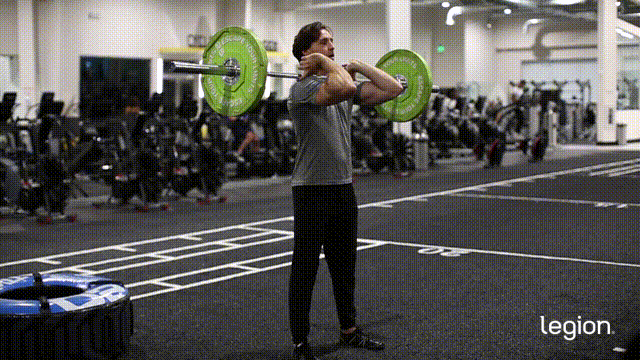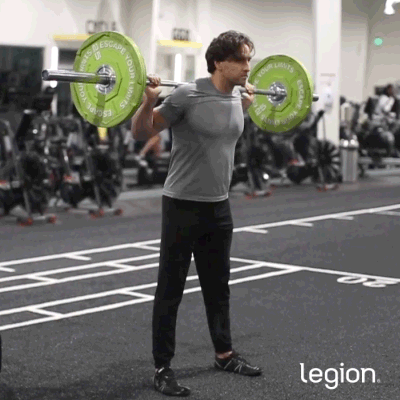The question of the back squat vs. front squat is an old one in weightlifting circles.
What’s the difference between front and back squats?
What are the benefits of each?
How do front vs. back squat variations impact muscle activation and growth?
And when it comes to front squat vs. back squat weight, which allows you to lift more weight?
Get evidence-based answers to these questions and more in this article.
The Difference Between Front and Back Squats
Bar Placement
The main difference between the front squat and back squat is the bar position.
In a back squat, you create a “shelf” with your rear deltoids for the bar to rest on, while in a front squat, the bar lies across the front of your shoulders, held against the base of your throat by your hands.
This shift in weight distribution from the front to the back influences which muscles you emphasize, how much weight you can lift, how the exercise affects your bones and joints, and how easy the exercise is to learn—all of which we’ll discuss now.
Muscles Worked
Both front and back squats engage the same primary muscle groups: the quadriceps, hamstrings, and glutes.
However, because you typically maintain a more upright back angle and squat deeper in the front squat, it’s slightly better at training the quads and upper back than the back squat.
In contrast, the back squat may be marginally better at training the lower back, glutes, and hamstrings than the front squat since it involves placing the bar lower on your back and leaning further forward.
Weight Lifted
You can usually lift more weight with back squats than with front squats as the back squat engages your posterior chain muscles (the muscle on the back of your body like the glutes and hamstrings) more.
This doesn’t mean the back squat is superior, though. Research shows that the front squat can train your quads equally effectively, even with up to 20% less weight.
People often refer to the amount of weight they can lift on the back squat relative to the weight they can lift on the front squat as their “front-squat-to-back-squat ratio.”
While estimates vary, most experts agree that your front squat one-rep max should be 70-to-90% of your back squat one-rep max. In other words, if you can back squat 200 pounds, you should be able to front squat 140-to-180 pounds.
Lower-Back and Knee Demands
Research shows that the front squat places considerably less compressive forces on your knees and lower back than the back squat, making it an excellent alternative to back squats for people with knee or back issues.
Ease of Learning
Generally, back squats are easier for beginners because the movement and bar placement feel more natural. Conversely, front squats require more mobility, particularly in the wrists and shoulders, and can take longer to master.
Front Squat vs. Back Squat: Muscles Worked
The front and back squat train almost every major muscle group in your lower body and many of the main muscle groups in your back.
Specifically, the muscles worked by the front and back squat include . . .
Front Squat vs. Back Squat: Form
Front Squat

- Position a barbell in a squat rack at about the height of your breastbone (usually an inch or two higher than you would for the barbell squat).
- Grab the bar with a shoulder-width grip and your palms facing away from you.
- Step closer to the bar so that it presses against the top of your breastbone, and push your elbows up and out in front of the bar.
- With the bar resting on the front of your shoulders and held in place by your hands, lift it out of the rack, take one or two steps backward, and place your feet a little wider than shoulder-width apart with your toes pointing slightly outward.
- Sit down and remember to keep your back straight, elbows up, and push your knees out in the same direction as your toes throughout each rep.
- Stand up and return to the starting position.
Back Squat

- Position a barbell in a squat rack at about the height of the top of your breastbone.
- Step under the bar, pinch your shoulder blades together, and rest the bar directly above the bony ridges on the bottom of your shoulder blades.
- Lift the bar out of the rack, take one or two steps backward, and place your feet a little wider than shoulder-width apart, with your toes pointing slightly outward.
- Sit down and remember to keep your back straight and push your knees out in the same direction as your toes throughout each rep.
- Stand up and return to the starting position.
Should You Front or Back Squat?
Front and back squats train many of the same muscles to a comparable degree and boost strength, muscle growth, and athletic performance similarly.
Both also allow you to lift heavy weights safely and progress regularly, which is crucial for gaining size and strength.
A bonus of the front squat is it puts less strain on your back and knees, potentially making it a preferable choice if you’re dealing with knee or lower-back pain.
On the other hand, the back squat is easier to learn, so it’s probably a better place to start for new weightlifters. It also allows you to lift the most weight, which means it’s probably more fitting for those looking to maximize strength.
Of course, most people have no reason to choose just one—the best solution is to include both exercises in your program.
A good way to do this is to include the back squat in your program for 8-to-10 weeks of training, take a deload, then replace the back squat with the front squat for the following 8-to-10 weeks of training.
Then, you can either continue alternating between the exercises every few months or stick with the one you prefer.
This is how I like to approach my training, and it’s similar to the method I advocate in my fitness books for men and women, Bigger Leaner Stronger and Thinner Leaner Stronger.
(And if you’d like even more specific advice about organizing your training to reach your health and fitness goals, take the Legion Strength Training Quiz, and in less than a minute, you’ll know the perfect strength training program for you. Click here to check it out.)
Scientific References +
- Krzyszkowski J, Kipp K. Load-dependent mechanical demands of the lower extremity during the back and front squat. Journal of Sports Sciences. 2020;38(17):2005-2012. doi:https://doi.org/10.1080/02640414.2020.1766738
- Contreras B, Vigotsky AD, Schoenfeld BJ, Beardsley C, Cronin J. A Comparison of Gluteus Maximus, Biceps Femoris, and Vastus Lateralis Electromyography Amplitude in the Parallel, Full, and Front Squat Variations in Resistance-Trained Females. Journal of applied biomechanics. 2016;32(1):16-22. doi:https://doi.org/10.1123/jab.2015-0113
- Yavuz HU, Erdağ D, Amca AM, Aritan S. Kinematic and EMG activities during front and back squat variations in maximum loads. Journal of Sports Sciences. 2015;33(10):1058-1066. doi:https://doi.org/10.1080/02640414.2014.984240
- Gullett JC, Tillman MD, Gutierrez GM, Chow JW. A Biomechanical Comparison of Back and Front Squats in Healthy Trained Individuals. Journal of Strength and Conditioning Research. 2009;23(1):284-292. doi:https://doi.org/10.1519/jsc.0b013e31818546bb
- Strength, Power, and Speed Qualities in English Junior Elite Rugby League Players. Research Gate. Published December 2012. https://www.researchgate.net/publication/233957866_Strength_Power_and_Speed_Qualities_in_English_Junior_Elite_Rugby_League_Players/citation/download
- Behrens MJ, Simonson SR. A Comparison of the Various Methods Used To Enhance Sprint Speed. Strength and Conditioning Journal. 2011;33(2):64-71. doi:https://doi.org/10.1519/ssc.0b013e318210174d
- Peeni M. The Effects of the Front Squat and Back Squat on Vertical Jump and Lower Body Power Index of Division 1 Male Volleyball Players.; 2007. https://scholarsarchive.byu.edu/cgi/viewcontent.cgi?article=1929&context=etd










